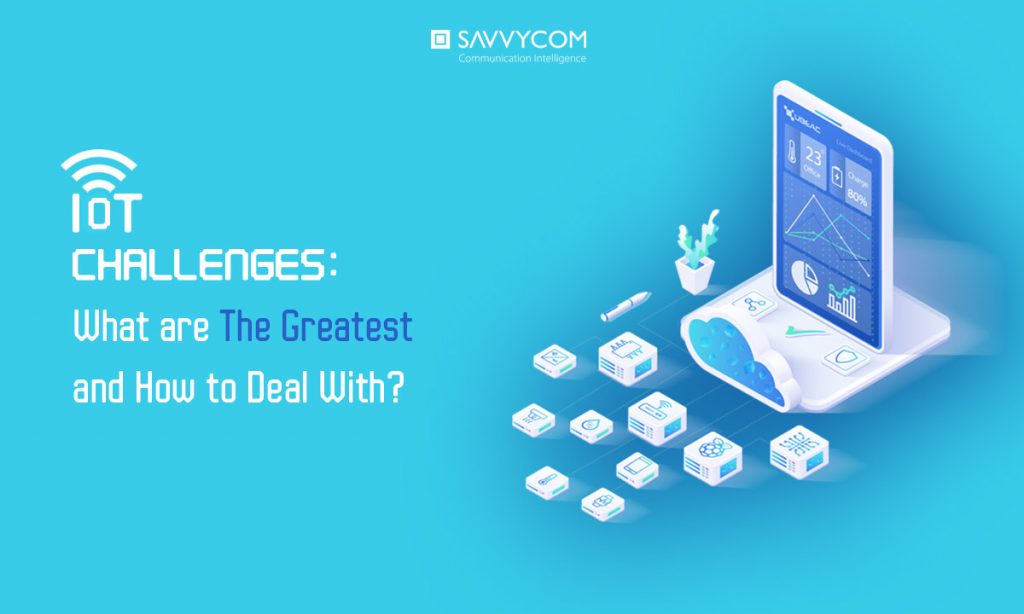IoT Challenges: What are The Greatest and How to Deal With?

What are 7 unique issues with IoT Solutions?

Internet of Things – characteristics and challenges (Infographic) | Source: Savvycom.
1. The Capability to Keep Up With the Velocity of Data
One of IoT’s most outstanding trait is its ability to keep data moving in real time. Under the control of IoT, data is continuously transferred from one device to another and end up at your mobile phone, your laptop or your PC – whichever plays the role of a control system. Data collected will, therefore, be analysed so that users could extract useful and valuable information needed for their specific purposes.
Hence, IoT can be seen as a streaming solution. Thanks to IoT, users will constantly be given a heads up on devices’ status, the working state and the process. Any change in data patterns will be identified in no time, therefore, notify users with critical issues. Once the problems are pointed out, users can act on the necessities before anything worse happens.

Source: Mindinventory.
Let’s take REALM, a product designed by Savvycom engineer team. It is a smart GPS tracker using IoT technology that allows users to form a group tracking among drivers heading to the same destination and maintain communication with each other in real time.

Source: Savvycom.
2. A Massive Amount of Data
IoT is distinct for pulling everything into one single place. No matter it’s image, video, audio, vibration, temperature, humidity, pressure or anything, as long as it is counted as data, IoT can connect them all.

Source: vietsunshine.
A good example of this functionality is smartwatches. Let’s take Apple Watch as a more specific case. By collecting one’s personal data, an Apple Watch can measure the heart rate, count the walking steps, update the daily weather, elaborate and convert them into notifications, such as alerting when one’s sitting too long or reminding one to drink an adequate amount of water.
3. IoT Sensors Challenges
In the IoT network, one device is appointed as the “server”, the heart and brain that control all connected devices around. It takes charge of gathering and managing every data and information other devices emit to IoT, analysing and representing it to users.
In case there is any following action required, the server will send orders back to those devices wirelessly. Therefore, the locations become less of importance: IoT could easily control all of them with just one single device at a single place.

Source: Medium.
By downloading the IoT controller app to smartphones, users will be able to keep track of the working state of devices and identify critical issues beforehand, which will help users avoid lots of negative scenarios in the future.
4. Immaturity of IoT standards
In order to collect data and transmit the analysed information and users’ orders back to the devices, wireless communication is an indispensable companion to IoT. Therefore, the more developed wireless technology is, the more efficient IoT systems become.
Nowadays, wireless technology has advanced to quite an extent. There are many ways that data sensors can communicate to a central point: Bluetooth, Bluetooth low energy, Wi-Fi, Internet USB, 2G, 3G, 4G or even 5G.
Furthermore, various wireless communication can be used at the same time to maximise the efficiency of data delivery, as long as they are well managed. It may be Blue Tooth Low Energy (BTLE) that is used at the edge to connect multiple devices to an interim ‘aggregator’, and only after then that Wi-Fi is used to send data onto the central systems.
With the help of such advanced wireless communications, the standards of IoT go higher and higher as days pass, promising an era of automation and absolute convenience ahead.
5. IoT Cloud Challenges
As mentioned in the second category, IoT can not only collect and analyse data but also store and manage those data for further use as well as other revisions in the future. The reason why IoT is capable of saving and dealing with such a giant amount of data is that its core system is located in Cloud.

Source: Workplace Insight.
Cloud can also eliminate integration’s need and prevent data’s overloading, which helps devices run more smoothly.
6, Integration Challenges Facing IoT
IoT solutions often need much more than just sensor-based data to become useful. Reports from engineers held in content management systems, ERP (scheduling), and Asset management systems within the enterprise may also need to be brought in.
However, the more components there are in the system, the more complex and confused it would be for users. Therefore, integration across all system factors is needed so that the whole process won’t be messed up:
“Integration helps capture data from smart devices and move it into business applications to automate processes, support real-time monitoring and apply analytics for insights.” – Perficient guide, The Why, What and How of IoT: 50+ examples across 11 industries
7. Security & Privacy
Because IoT can connect with a variety of devices, each of which is distributed different geolocations and run by different principles and standards, maintaining a consistent level of security across the whole system becomes critically hard. Therefore, IoT’s firewall is not really strong and later results in information breaches as well as outsiders’ illegal infiltration.

Source: Arcserve
Contact us for better IoT solutions:
- Phone: +84 24 3202 9222
- Hotline: +84326752886
- Email: [email protected]
- Website: https://savvycomsoftware.com/
